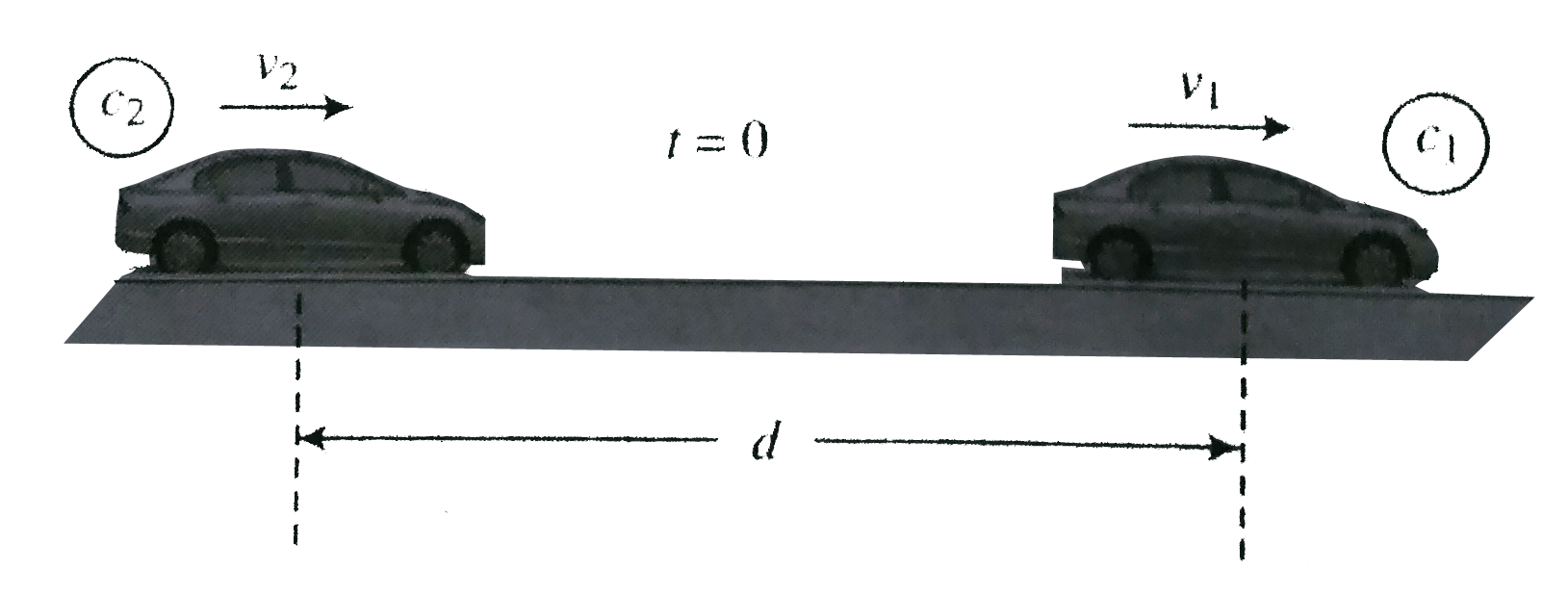Two bodies starts moving from same point along straight line with velocities v1=6m/s and v2=10m/s
simultaneously. After what time the separation becomes 40 m ?
6 s
8 s
12 s
10 s
The correct Answer is:D
To solve the problem step by step, we will use the concept of relative motion.
1. Identify the velocities of the two bodies:
- Let the velocity of the first body (v1) be 6 m/s.
- Let the velocity of the second body (v2) be 10 m/s.
2. Determine the relative velocity:
- The relative velocity of the second body with respect to the first body can be calculated as:
vrel=v2−v1=10m/s−6m/s=4m/s
3. Set the relative distance:
- We want to find out when the separation between the two bodies becomes 40 meters. This is our relative distance (d).
- Therefore, d=40m.
4. Use the formula for time:
- The time (t) taken for the relative distance to be covered can be calculated using the formula:
t=dvrel
- Substituting the values we have:
t=40m4m/s=10s
5. Conclusion:
- The time after which the separation between the two bodies becomes 40 meters is 10 seconds.
- Let the velocity of the first body (v1) be 6 m/s.
- Let the velocity of the second body (v2) be 10 m/s.
- The relative velocity of the second body with respect to the first body can be calculated as:
vrel=v2−v1=10m/s−6m/s=4m/s
- We want to find out when the separation between the two bodies becomes 40 meters. This is our relative distance (d).
- Therefore, d=40m.
- The time (t) taken for the relative distance to be covered can be calculated using the formula:
t=dvrel
- Substituting the values we have:
t=40m4m/s=10s
- The time after which the separation between the two bodies becomes 40 meters is 10 seconds.
Topper's Solved these Questions
- BOOK - MOTIONCHAPTER - ONE DIMENSION MOTIONEXERCISE - EXERCSE -2 (Section - E : River Boat Problems)3videos
ONE DIMENSION MOTION
- BOOK - MOTIONCHAPTER - ONE DIMENSION MOTIONEXERCISE - EXERCSE -2 (Section - F : Rain Problems, Aircraft wind problems, Relative Motion between two projectiles )2videos
ONE DIMENSION MOTION
- BOOK - MOTIONCHAPTER - ONE DIMENSION MOTIONEXERCISE - EXERCSE -2 (Section - C : Graphs)12videos
ONE DIMENSION MOTION
- BOOK - MOTIONCHAPTER - NLM & FRICTIONEXERCISE - EXERCISE-4 ( LEVEL-II)15videos
NLM & FRICTION
- BOOK - MOTIONCHAPTER - OPTICSEXERCISE - Exercise45videos
OPTICS
Similar Questions
Two cars C1 and C2 moving in the same direction on a straight single lane road with velocities v1=12ms−1 and v2=10ms−1, respectively . When the separation between the two was d=200m, C2 started accelerating to avoid collision. What is the minimum acceleration of car C2 so that they do not collide?
 .View Solution
.View SolutionTwo particles A and B are projected simultaneously in the directins shown in figure with velocities vA=20m/sandvB=10m/s respectively. They collide in air after 12 s. Find
(a) the angle θ
(b) the distance x.
 . View Solution
. View Solution
Knowledge Check
- Question 1 - Select One
Two elastic bodies P and Q having equal mases are moving along the same line with velocities of 16 m/s and 10 m/s respectively. Their velocities after the elastic collision will be in m/s :
A0 and 25B5 and 20C10 and 16D20 and 5 - Question 2 - Select One
Two equal masses m1 and m2 moving along the same straight line with velocites +3m/s and −5m/s respectively collide elastically. Their velocities after the collision will be respectively.
A+4m/s for bothB−3m/sand+5m/sC−4m/sand+4m/sD−5m/sand+3m/s - Question 3 - Select One or More
A particle is moving on a straight line with constant retardation of 1m/s2. Its initial velocity is 10m/s.
AThe distance travelled by the particle till it comes to rest is 50 m.BThe average velocity till it comes to rest is 5m/s.CIt comes to rest in 5 sec.DIts velocity after 5 sec is 5m/s
A rigid body in shape of a triangle has vA=5m/s⏐↓,vB=10m/s⏐↓.
Find velocity of point C.
 .View Solution
.View Solutiona particle moving along a straight line with uniform acceleration has velocities 7m/s at A and 17m/s at C. B is the mid point of AC. Then :-
View SolutionTwo particles P and Q simultaneously start moving from point A with velocities 15m/s and 20m/s respectively. The two particles move with acceleration equal in magnitude but opposite in direction. When P overtakes Q and B then its velocity is 30m/s the velocity of Q at point B will be
View SolutionTwo particles A and B of masses 10 kg and 38 kg, respectively, are moving along the same straight line with velocities 15 m/s and 3 m/s, respectively, in the same direction. After elastic collision, the velocities of A and B are vAand vB, respectively, in the direction of initial motion. Then
 View Solution
View SolutionA body of mass 1kg is moving along a straight line with a velocity of 1m/s. The external force acting in the body is
View Solution

